Table of Contents
- Introduction
- Editor’s Choice
- Global Functional Foods Market Overview
- Nutritional Content of Functional Foods Statistics
- Sales of Functional Food Ingredients – By Regional Statistics
- Addition of Functional Foods Ingredients to the Diet Statistics
- Consumer Preferences
- Regulations for Functional Foods in Various Nations Statistics
- Recent Developments
- Conclusion
- FAQs
Introduction
Functional Foods Statistics: Functional foods, that offer additional health benefits beyond basic nutrition, are essential in the health and nutrition sectors.
These include both natural and modified foods enriched with components like fiber, vitamins, and probiotics to support health, such as boosting digestion and immunity and reducing disease risk.
With the functional foods market growing due to heightened health consciousness, an aging demographic, and healthcare costs, the sector faces challenges in proving health claims and ensuring taste.
However, the evolving food science field and increased health interest present promising expansion prospects, highlighting its crucial impact on improving global health.
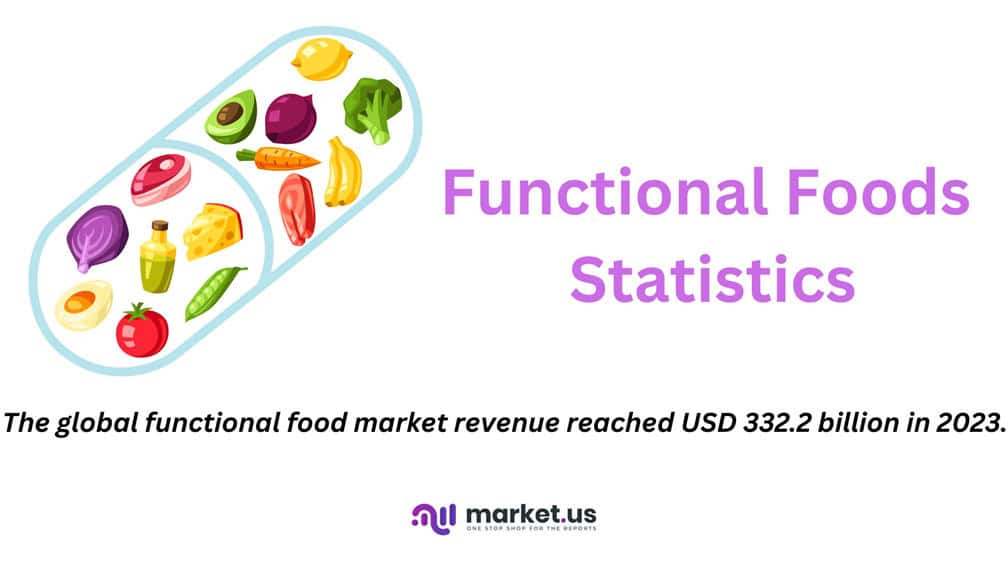
Editor’s Choice
- The global functional foods market revenue is projected to reach USD 678.3 billion by 2032.
- Among the product categories, dairy products have consistently led the market, with revenues growing from USD 91.9 billion in 2022 to USD 203.5 billion in 2032.
- In the composition of the functional foods market, vitamins lead with a market share of 30%, underscoring their pivotal role in enhancing health beyond basic nutrition.
- Fortified cereals may contain approximately 25-100% of the recommended daily intake (RDI) for various vitamins and minerals per serving.
- North America led the surge in the sale of functional food ingredients, escalating from USD 20,930 million in 2016 to USD 32,015 million by 2023.
- According to the survey data, a majority of respondents, constituting 55%, expressed a preference for incorporating functional ingredients into their diet through supplements, such as tablets, capsules, gummies/chewables, or tinctures.
- In 2021, 7% of consumers in the United States acknowledged that FFAB could be beneficial to the body, recognizing their potential health advantages.
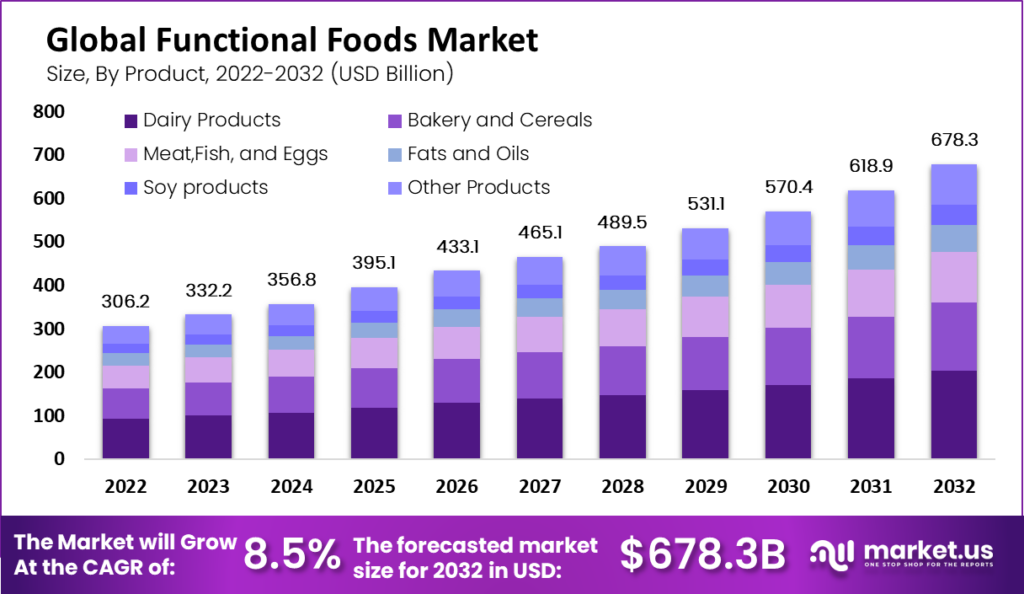
Global Functional Foods Market Overview
Global Functional Foods Market Size Statistics
- The global functional foods market has shown a significant upward trend in revenue from 2022 to 2032 at a CAGR of 8.5%.
- Starting at USD 306.2 billion in 2022, the market experienced steady growth, reaching USD 332.2 billion in 2023, and is projected to continue growing to USD 356.8 billion in 2024.
- The upward trajectory is expected to persist, with market revenues forecasted to climb to USD 395.1 billion in 2025, USD 433.1 billion in 2026, and further to USD 465.1 billion by 2027.
- The growth momentum is anticipated to be sustained, with the market expanding to USD 489.5 billion in 2028, USD 531.1 billion in 2029, and USD 570.4 billion in 2030.
- The market is projected to reach new heights with revenues of USD 618.9 billion in 2031, culminating in an impressive USD 678.3 billion by 2032.
- This consistent growth underscores the increasing consumer demand and market potential for functional foods over the decade.
(Source: Market.us)

Global Functional Foods Market Size- By Product Statistics
- The global functional foods market has exhibited robust growth from 2022 to 2032 among different product types.
- Among the product categories, dairy products have consistently led the market, with revenues growing from USD 91.9 billion in 2022 to USD 203.5 billion in 2032.
- Bakery and cereals followed, with their revenue rising from USD 70.4 billion to USD 156.0 billion over the same period.
- The meat, fish, and eggs category also showed significant growth, from USD 53.3 billion to USD 118.0 billion.
- Fats and oils, as well as soy products, have seen substantial increases in their market shares, with revenues moving from USD 27.6 billion and USD 21.4 billion in 2022 to USD 61.0 billion and USD 47.5 billion in 2032, respectively.
- The ‘other products’ category rounded out the market, expanding from USD 41.6 billion in 2022 to USD 92.2 billion by 2032.
- This decade-long trend underscores the dynamic expansion and diversification within the functional foods sector, highlighting a growing consumer emphasis on health and nutrition.
(Source: Market.us)
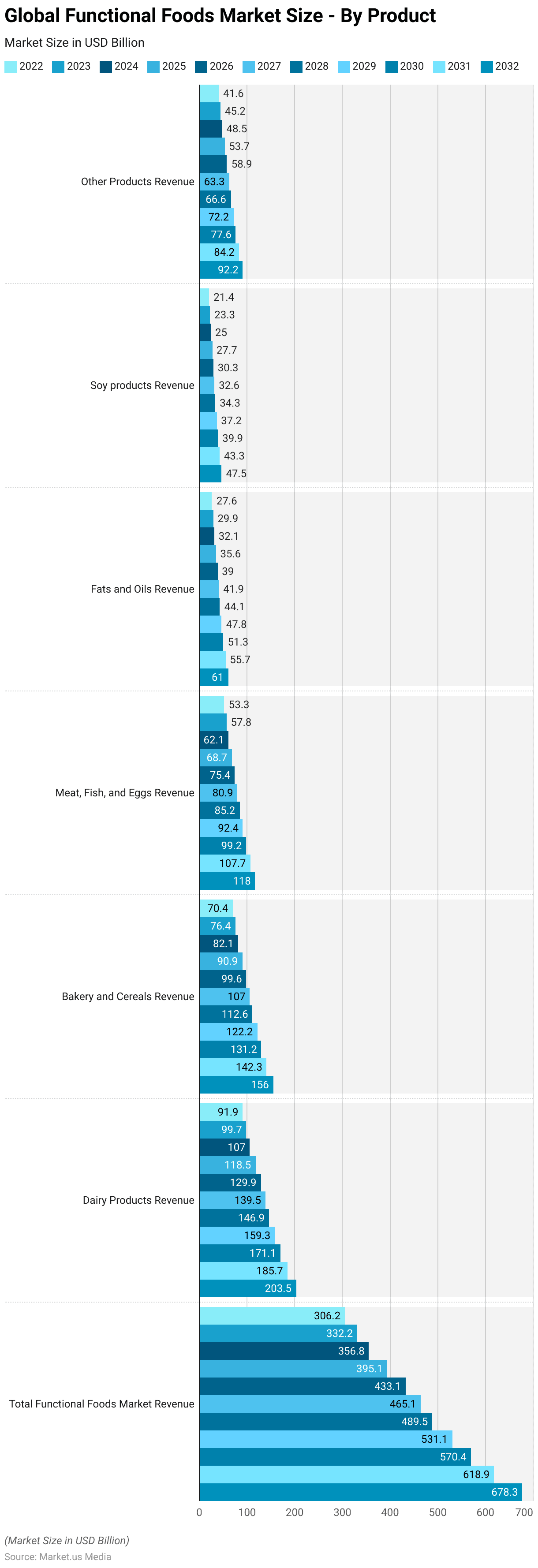
Global Functional Foods Market Share- By Ingredient Statistics
- In the composition of the functional foods market, vitamins lead with a market share of 30%, underscoring their pivotal role in enhancing health beyond basic nutrition.
- Carotenoids follow closely, contributing to 24% of the market, and are recognized for their antioxidant properties and health benefits.
- Dietary fibers hold a 14% share, highlighting their importance in digestive health and disease prevention.
- Minerals, essential for various bodily functions, account for 13% of the market. Probiotics and prebiotics, known for their beneficial effects on gut health, comprise 5% of the market.
- The remaining 14% is attributed to other ingredients, showcasing the diversity and innovation within the functional foods sector.
- This distribution reflects the dynamic nature of the market and the growing consumer demand for products that support overall health and well-being.
(Source: Market.us)
Take advantage of our unbeatable offer - buy now!

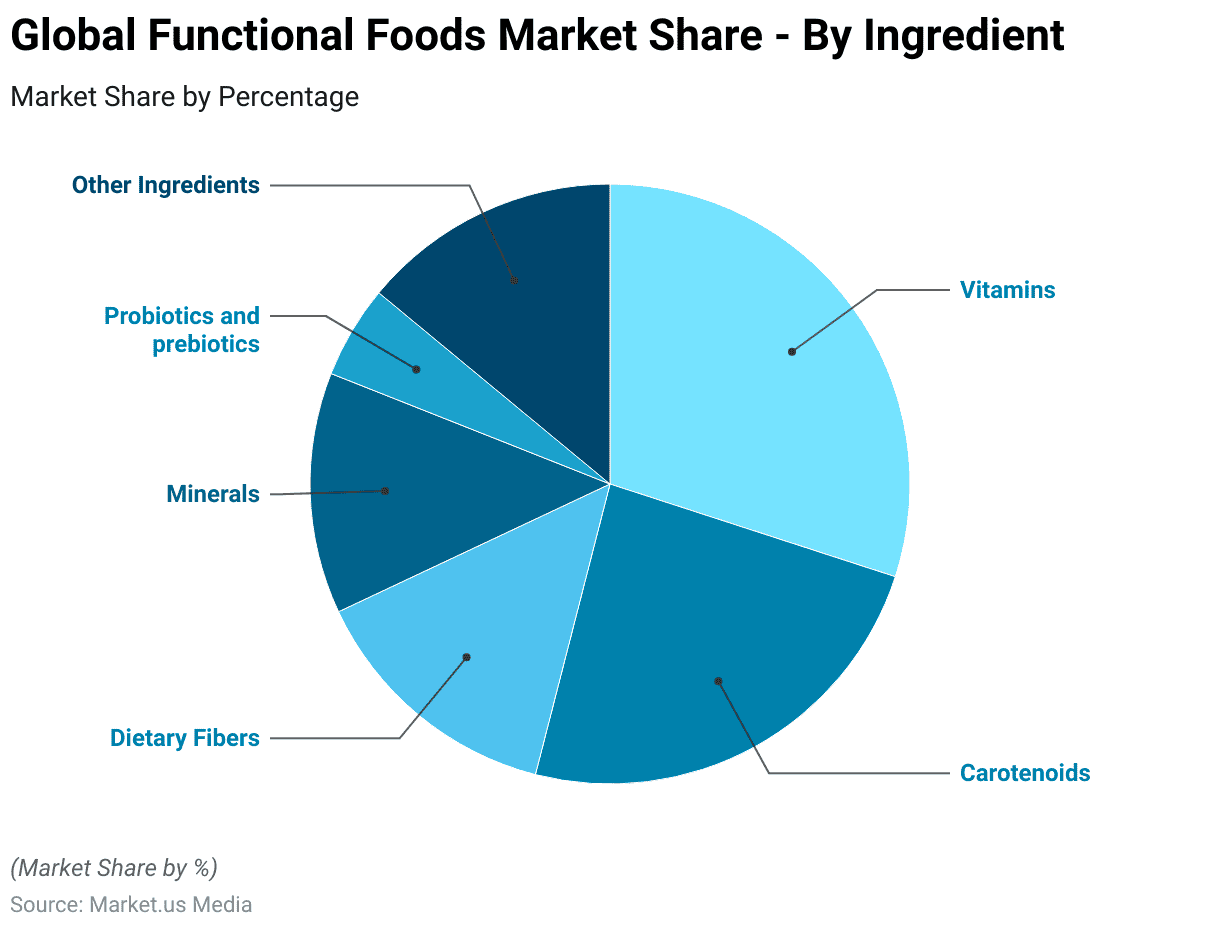
Nutritional Content of Functional Foods Statistics
Vitamins and Minerals
- Fortified cereals may contain approximately 25-100% of the recommended daily intake (RDI) for various vitamins and minerals per serving.
- Fortified milk may provide around 30-50% of the RDI for calcium and vitamin D per cup.
- Vegetables like spinach and kale are rich sources of vitamins A, C, and K, providing well over 100% of the RDI per serving.
(Source: IntechOpen)
Antioxidants
- Blueberries typically contain around 5-9 millimoles of antioxidants per 100 grams.
- Dark chocolate with a high cocoa content (70-85%) may provide approximately 15-20 millimoles of antioxidants per 100 grams.
(Source: IntechOpen)
Omega-3 Fatty Acids
- Fatty fish like salmon typically contain around 1-2 grams of omega-3 fatty acids per 100 grams.
- Flaxseeds and chia seeds provide approximately 18-25 grams of alpha-linolenic acid (ALA), a type of omega-3 fatty acid, per ounce (28 grams).
(Source: IntechOpen)
Probiotics and Prebiotics
- A serving of yogurt with live cultures may contain around 1-10 billion CFUs of probiotics.
- Prebiotic-rich foods like chicory root may provide 2-5 grams of inulin fiber per tablespoon.
(Source: IntechOpen)
Fiber
- Fiber content varies widely among foods, with whole grains, legumes, fruits, and vegetables typically providing several grams of fiber per serving.
- One cup of cooked lentils contains approximately 15-16 grams of dietary fiber.
- An apple with the skin intact provides about 4-5 grams of fiber.
(Source: IntechOpen)
Phytochemicals
- Quantifying phytochemicals can be challenging as they encompass a wide range of compounds with varying concentrations.
- However, specific compounds like curcumin in turmeric may be present in concentrations ranging from 2-5% by weight.
(Source: IntechOpen)
Plant Sterols and Stanols
- Fortified foods containing plant sterols and stanols may provide around 0.5-2 grams per serving, to achieve a daily intake of 2 grams for cholesterol-lowering effects.
(Source: IntechOpen)
Sales of Functional Food Ingredients – By Regional Statistics
- From 2016 to 2023, the global market for functional food ingredients witnessed significant growth across various regions.
- North America led the surge, with sales escalating from USD 20,930 million in 2016 to USD 32,015 million by 2023, indicating a robust demand for health-enhancing food components.
- Europe followed closely, with its sales increasing from USD 19,555 million in 2016 to USD 28,798 million in 2023, reflecting a steady appetite for functional foods.
- The Asia Pacific region also showed remarkable growth, starting from USD 13,139 million in 2016 and reaching USD 21,445 million in 2023, as awareness and consumption of functional ingredients expanded.
- South America, while smaller in market size compared to the other regions, experienced consistent growth from USD 7,639 million in 2016 to USD 11,948 million in 2023, underscoring the increasing recognition of the health benefits associated with functional food ingredients.
- This upward trend across all regions highlights the growing global interest in functional foods as consumers worldwide seek healthier dietary options.
(Source: Statista)
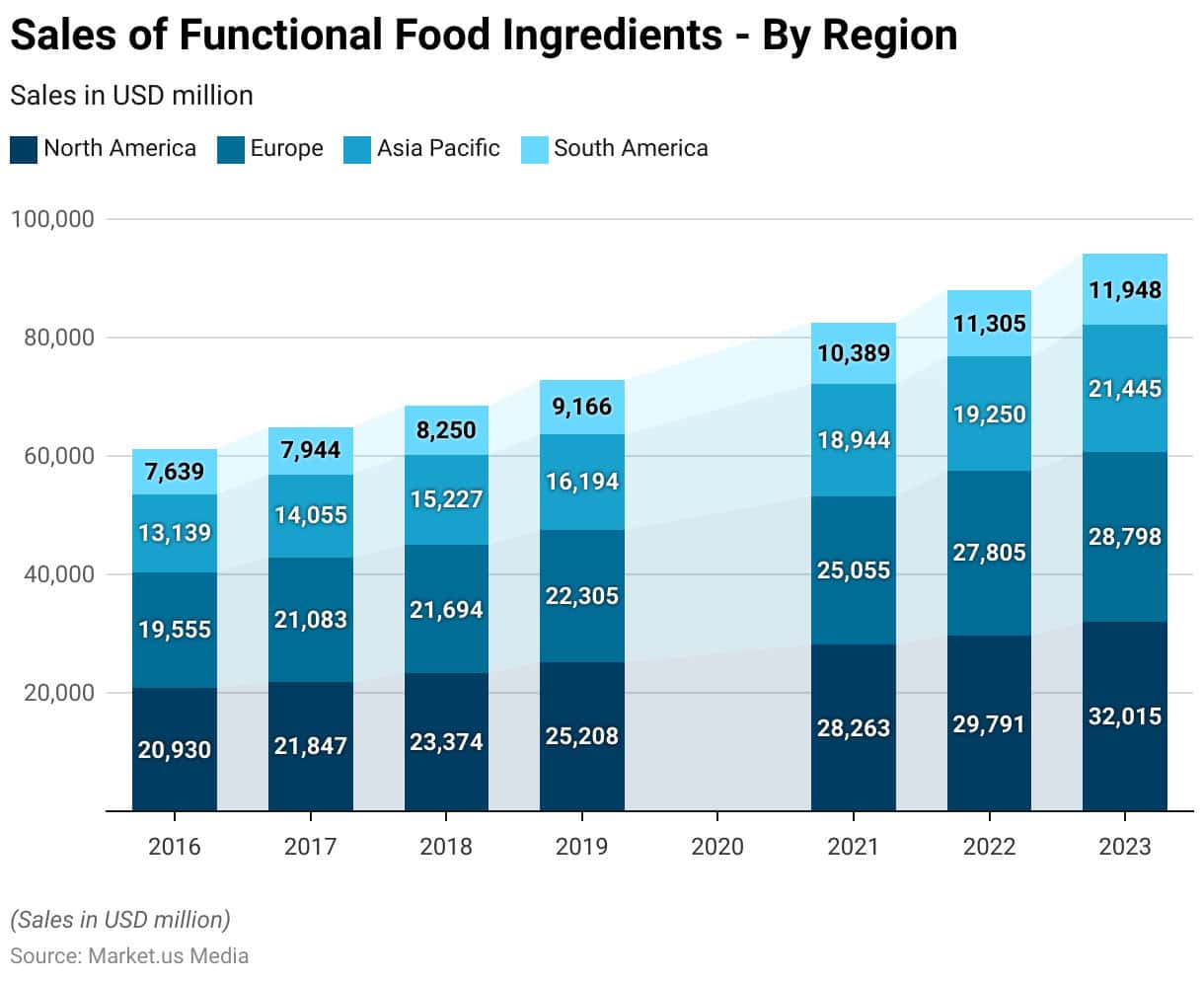
Addition of Functional Foods Ingredients to the Diet Statistics
- According to the survey data, a majority of respondents, constituting 55%, expressed a preference for incorporating functional ingredients into their diet through supplements, such as tablets, capsules, gummies/chewables, or tinctures.
- Close behind, 45% favored inherently nutritious and naturally functional foods without requiring fortification, such as whole grains and fresh produce.
- In terms of beverages, 35% leaned towards inherently functional options like bottled water or fruit/vegetable juice.
- However, a notable portion, 25%, showed a preference for functional foods with added fortification, while 21% favored fortified beverages.
- Interestingly, 15% indicated no specific preference and were open to using any of the methods above to incorporate functional ingredients into their diet.
(Source: Functional Food & Beverage 2020 Report)
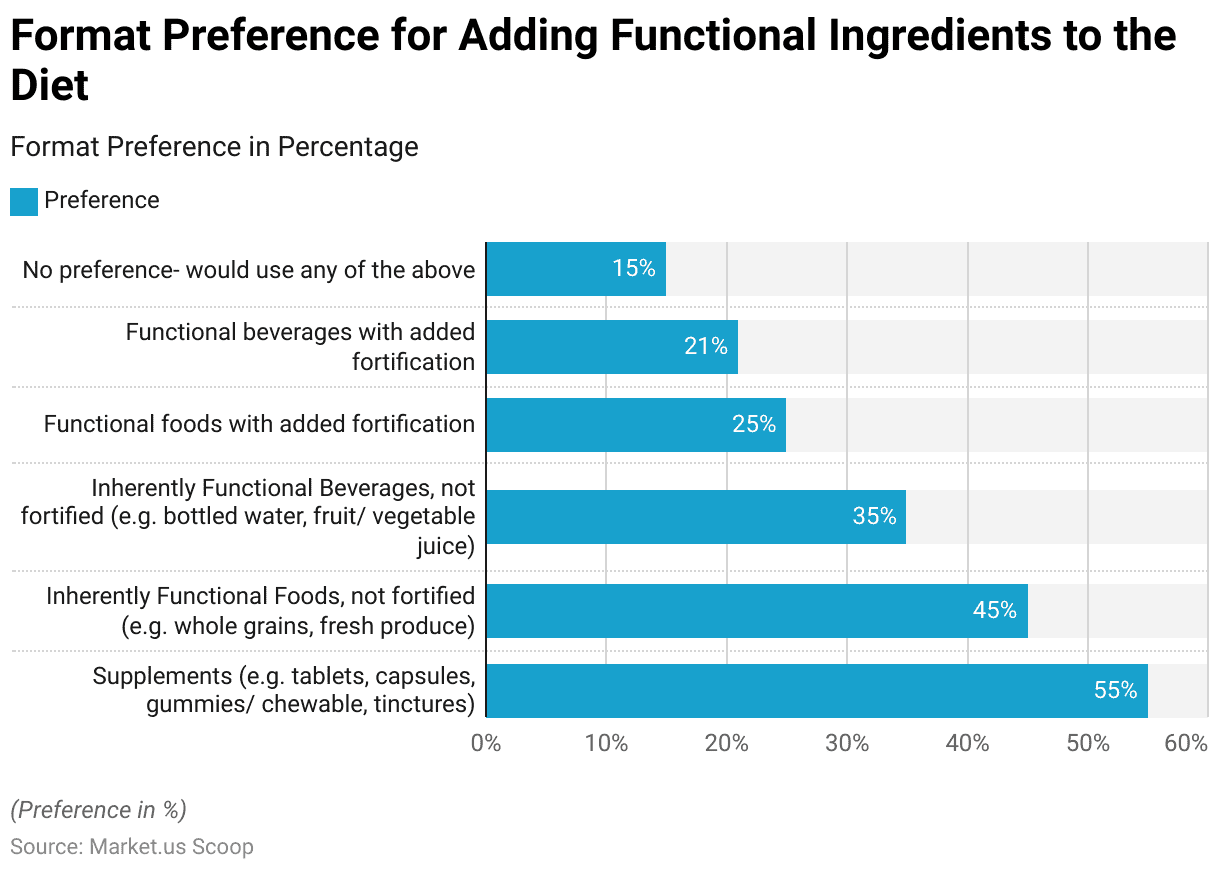
Consumer Preferences
Incorporation of Various Functional Foods Ingredients into the Diet Statistics
- Recent data reveals the top functional foods and ingredients that Americans are actively seeking to include in their diets.
- Topping the list is fiber, with 63% of consumers striving to incorporate it, followed closely by protein at 60% and vitamin D at 59%.
- Whole grains, nuts, and seeds are also highly sought after, with 58% and 57% respectively.
- Additionally, essential nutrients like calcium and healthy fats are being actively pursued by 54% and 39% of consumers, respectively.
- Notably, olive oil, antioxidants, and green tea are also popular choices, with 51%, 43%, and 42% of consumers aiming to add them to their diets, respectively.
- Meanwhile, omega-3 fatty acids and fish oil are sought after by 42% and 40% of consumers, highlighting a growing interest in heart-healthy fats.
- Probiotics and plant-based proteins are also gaining traction, with 38% and 32% of consumers incorporating them into their dietary habits.
- Rounding out the list, sea salt is being added by 31% of consumers as they strive to make healthier choices in their eating habits.
(Source: IFT)
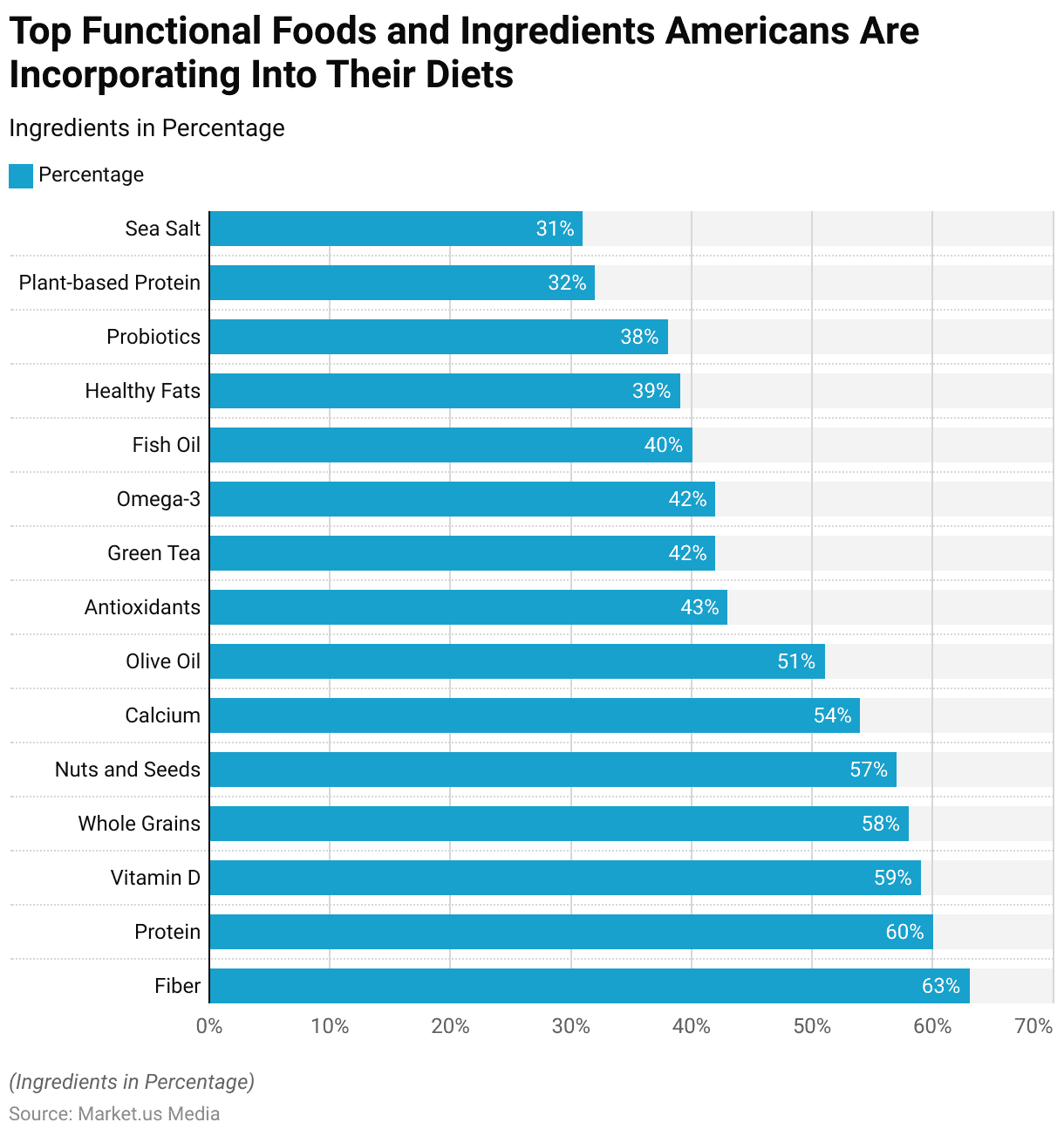
Consumers Perspective on Fortified Food and Beverages (FFAB)
- In 2021, consumers in the United States expressed various perspectives on fortified food and beverages (FFAB) through percentages.
- A notable portion, comprising 27%, acknowledged that FFAB could be beneficial to the body, recognizing their potential health advantages.
- Additionally, 24% recognized the widespread availability of FFAB in the food supply, indicating their prevalence in the market.
- A significant number, totaling 23%, believed that fortification played a crucial role in improving overall nutrition, highlighting its importance in enhancing dietary quality.
- Moreover, 23% viewed FFAB as a convenient means to increase vitamin intake, while 21% recognized their ability to boost nutrient density.
- A similar percentage, also at 21%, considered fortification the safest method for adding essential vitamins to the diet, emphasizing safety concerns.
- However, only 15% indicated actively seeking out FFAB, suggesting varying levels of consumer engagement with these products despite their perceived benefits and convenience.
(Source: Food Insight IFIC- Internal Food Information Council)
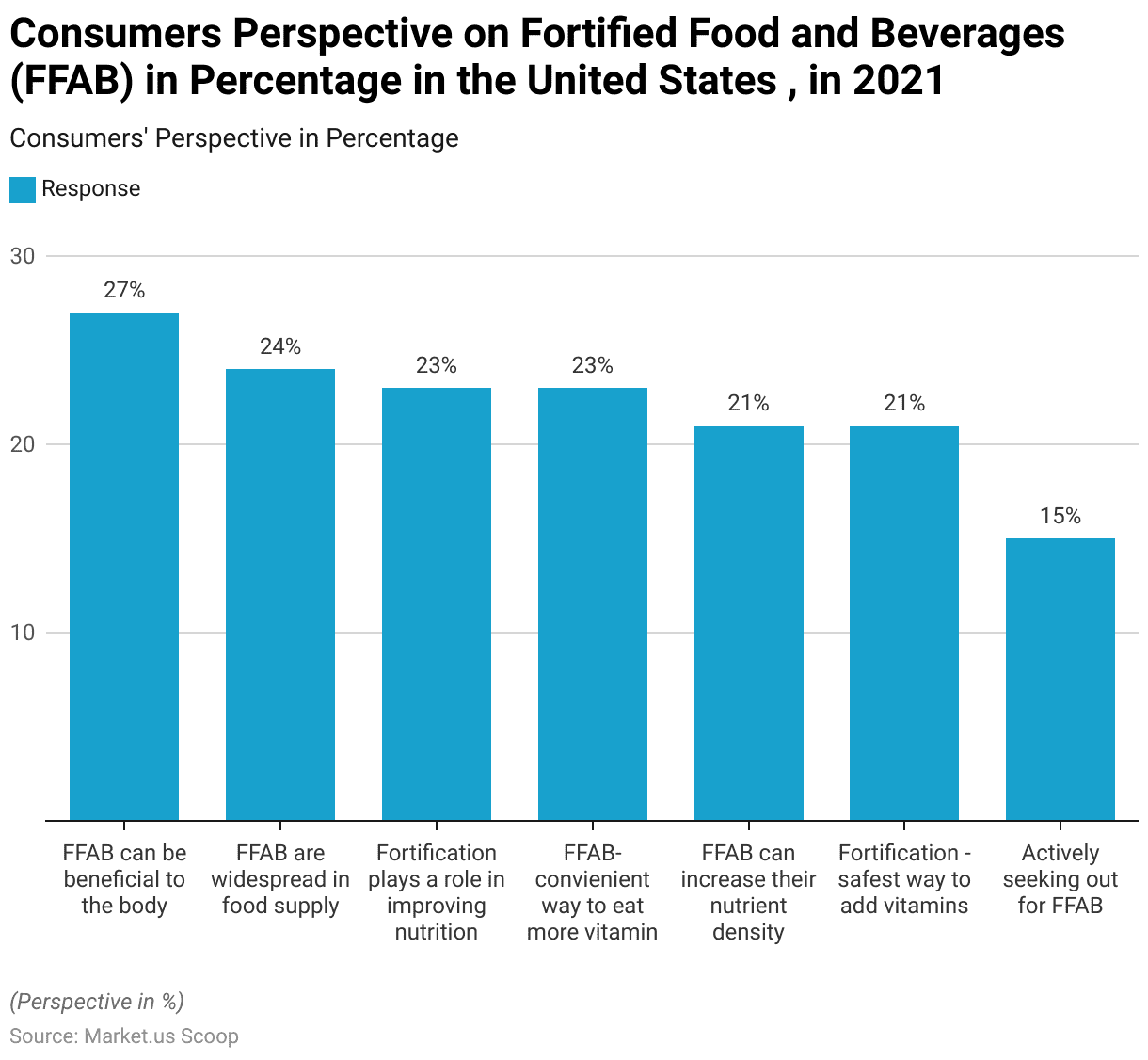
Regulations for Functional Foods in Various Nations Statistics
United States (U.S.)
- In the U.S., functional foods are regulated by the Food and Drug Administration (FDA) under the category of “dietary supplements” or “conventional foods.”
- The Dietary Supplement Health and Education Act (DSHEA) of 1994 governs dietary supplements, while the Federal Food, Drug, and Cosmetic Act (FD&C Act) regulates conventional foods, including functional foods.
- The FDA requires that functional foods and dietary supplements be safe for consumption and have accurate labeling, including claims about health benefits.
- Specific health claims on functional foods must meet certain criteria outlined in the Nutrition Labeling and Education Act (NLEA) and must be supported by scientific evidence.
(Source: NutraIngredients-USA)
European Union (EU)
- In the EU, functional foods fall under the category of “novel foods” or “dietary supplements.”
- The European Food Safety Authority (EFSA) evaluates novel foods to ensure they are safe for consumption before they can be placed on the market.
- Regulation (EU) 2015/2283 on novel foods governs the authorization and marketing of novel foods in the EU.
- Health claims on functional foods are regulated under Regulation (EC) No 1924/2006, which requires scientific substantiation for any claims made.
(Source: JRC Publications Repository)
Japan
- In Japan, functional foods are known as “Foods for Specified Health Uses” (FOSHU) and are regulated by the Ministry of Health, Labour and Welfare (MHLW).
- FOSHU must undergo rigorous testing to demonstrate their safety and efficacy before they can be marketed with specific health claims.
- The Japanese government also regulates functional foods through the Food Sanitation Act and other relevant legislation to ensure consumer safety and proper labeling.
(Source: Food Navigator)
Australia and New Zealand
- In Australia and New Zealand, functional foods are regulated as either “foods” or “therapeutic goods” depending on their intended use and health claims.
- The Food Standards Australia New Zealand (FSANZ) regulates the safety and labeling of foods, including functional foods, under the Australia New Zealand Food Standards Code.
- Health claims on functional foods are regulated by the Therapeutic Goods Administration (TGA) in Australia and the Ministry for Primary Industries (MPI) in New Zealand
(Source: Ministry for Primary Industries – Government of New Zealand)
Recent Developments
Acquisitions and Mergers:
- Acquisition of Nutrafol by Unilever: In a significant move aimed at expanding its presence in the health and wellness sector, Unilever acquired Nutrafol, a leading provider of hair wellness solutions.
- The deal, valued at $700 million, underscores Unilever’s commitment to tapping into the growing market for functional foods targeting specific health concerns.
New Product Launches:
- Beyond Meat’s Expansion into Plant-Based Functional Foods: Beyond Meat, renowned for its plant-based meat alternatives, has ventured into the functional foods market with the launch of Beyond Breakfast Sausage® Links.
- Packed with plant-based protein and fortified with essential nutrients, these sausage links cater to the growing demand for convenient, nutritious breakfast options.
- Within the first month of its launch, sales surpassed 500,000 units, indicating strong consumer interest in functional plant-based foods.
Funding:
- Fresh Capital Injection for Oatly: Oatly, a Swedish oat milk company, secured $200 million in funding in its latest financing round led by Blackstone Group Inc. and supported by celebrities like Oprah Winfrey and Natalie Portman.
- The substantial investment underscores the surging demand for plant-based alternatives and positions Oatly for further expansion into the functional foods market.
Strategic Partnerships:
- PepsiCo’s Collaboration with Driftwood Dairy: PepsiCo, a global leader in the food and beverage industry, announced a strategic partnership with Driftwood Dairy to co-develop a new range of functional dairy products.
- Leveraging Driftwood Dairy’s expertise in dairy processing and PepsiCo’s extensive distribution network, the collaboration aims to introduce innovative dairy-based functional beverages enriched with probiotics and vitamins, catering to health-conscious consumers seeking convenient, on-the-go options.
Investment in Research and Development:
- Nestlé’s Commitment to Innovation: Nestlé, a leading multinational food and beverage company, announced a multimillion-dollar investment in research and development (R&D) focused on functional foods and personalized nutrition.
- With a dedicated team of scientists and nutritionists, Nestlé aims to pioneer breakthroughs in food science, creating tailored solutions to address specific health needs and preferences of consumers worldwide.
Conclusion
Functional Foods Statistics – The functional foods sector has seen remarkable growth due to an increasing focus on health and nutrition among consumers.
Products enriched with vitamins, minerals, probiotics, and other health-enhancing components have become highly sought after globally.
Sales data from various regions between 2016 and 2023 reflects this trend, showing significant market expansion in North America, Europe, Asia Pacific, and South America.
Despite challenges related to health claim substantiation and maintaining product appeal, advancements in food technology and supportive regulatory frameworks are propelling the industry forward.
This growth underscores the shifting consumer preference towards dietary choices that support health and well-being, positioning functional foods as a crucial component of modern diets and preventative healthcare strategies.
FAQs
Functional foods are foods that have been shown to have potential health benefits beyond basic nutrition. These include foods naturally rich in healthful components, as well as foods that have been fortified, enriched, or enhanced with additional nutrients or bioactive compounds.
While all foods provide basic nutritional value, functional foods offer additional health benefits that may reduce the risk of disease or promote optimal health. These benefits are typically linked to specific ingredients or compounds within the foods, such as dietary fibers, vitamins, minerals, probiotics, and antioxidants.
Functional foods can contribute to a healthier diet and may help reduce the risk of certain diseases, such as heart disease, diabetes, and certain cancers. However, they are not a substitute for a balanced diet and a healthy lifestyle, nor can they treat diseases on their own.
Functional foods are generally considered safe for consumption as part of a balanced diet. However, individuals with allergies, specific health conditions, or those taking certain medications should consult healthcare professionals before integrating new functional foods into their diets, especially those that are fortified or enriched with bioactive compounds.
Yes, the regulation of functional foods varies by country, focusing on ensuring that health claims made by manufacturers are backed by scientific evidence and that the products are safe for consumption. In many regions, functional foods are subject to strict regulatory scrutiny to ensure consumer safety and informed choices.
Discuss your needs with our analyst
Please share your requirements with more details so our analyst can check if they can solve your problem(s)



